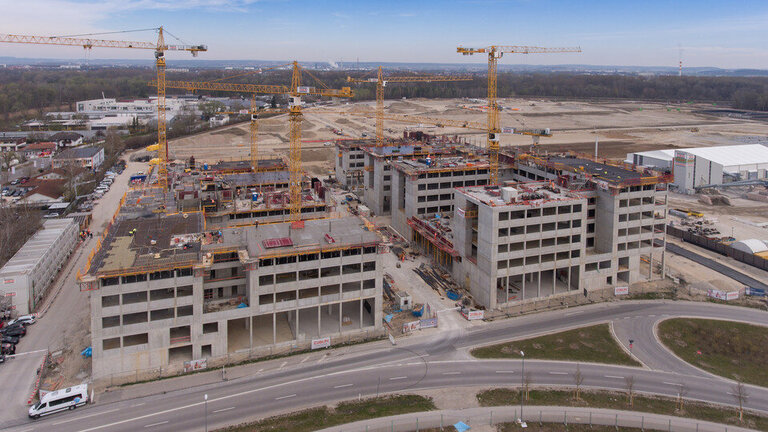It is not only the increased consumption of TV series on Netflix, Amazon Prime etc. that is putting data center capacities through a tough test. Countless emails, social media posts, video conferences and crypto-currencies such as Bitcoin are also contributing to colossal data traffic. The result is extremely high energy consumption. ‘Proposals for environmentally-friendly data centers must also become more widespread in Germany,’ said Klaus Dederichs, Head of ICT at Drees & Sommer, the Stuttgart-based consulting and planning company specializing in construction and real estate. Ongoing projects such as IN-Campus – the Audi Technology Park of the Future in the German city of Ingolstadt are setting a good example with a sophisticated approach to energy and waste heat recovery.
A study recently published by Germany’s digital association Bitkom1 reports that the CO2 equivalent of data centers and communication networks globally is around 200 to 250 megatons. ‘Our everyday digital life, both at work and home, requires enormous amounts of electricity, causes CO2 and has a considerable impact on the climate. Streaming one hour on Netflix requires the same amount of energy as driving a car through an urban area for about seven kilometers,’ explained the Head of ICT.
Consumption Equivalent to Berlin's Power Requirements
Going forward, greener data centers will have to contribute to more environmentally-friendly energy consumption for digitization. It is estimated that data centers will account for up to one-fifth of global electricity consumption by 20252. The exact figure worldwide at present is unclear, as many operators are not disclosing the relevant information. The bandwidth ranges from 200 to 500 billion kWh per year. According to calculations by the Borderstep Institute for Innovation and Sustainability, more than 55,000 German data centers, many of which are operated by companies or banks themselves, accounted for approximately 13 billion kilowatt-hours per year3. This corresponds to the total annual electricity requirements of a large city such as Berlin.
Upside Potential for Waste Heat
At Drees & Sommer, Klaus Dederichs and his ICT team are currently supervising the design, construction and operation of a number of data centers. Concerning operation, it is not only renewable energy that offers tremendous potential in terms of sustainability. Drees & Sommer’s ICT specialist sees potential especially in the use of waste heat.
Andreas Ahrens, data center expert at Drees & Sommer, agrees with him: ‘When data centers are operating, the servers heat up. They need constant cooling. The heat that is generated is dissipated instead of being used to heat adjacent office buildings, apartments or greenhouses.’ In contrast to Sweden, there are still too few data centers in Germany that are connected to the local and district heating networks. In Stockholm, there are already around 30 data centers that feed their waste heat into the Stockholm district heating network. They are even expected to cover about ten percent of the heating needs of Sweden’s capital city by 2035.
Guaranteed Consumers in Both Summer and Winter
The data center expert explained why waste heat utilization in Germany is still lagging behind: ‘A data center emits waste heat throughout the whole year. Neighboring consumers are therefore ideal, as they need the waste heat for heating all the time, not only in winter. This refers to swimming pools, laundries or agricultural projects such as urban farming. A city or local authority must take this into account at an early stage when issuing permits, to promote smart neighborhood planning.’
According to Ahrens, the temperature of the waste heat at most data centers – up to 30 degrees Celsius – is usually not sufficient for direct heating purposes. In this case, it could be worth considering the installation of low-temperature heating systems in the adjacent office and residential buildings. Alternatively, data center operators could also use heat pumps to increase temperature. ‘However, this increases operators’ already substantial production and operating costs. So to make the investment worthwhile for operators, the cost of raising the temperature must be lower than the selling price of the heat,’ explained the data center expert.
IN-Campus – the Audi Technology Park of the Future with Pioneering Zero-Energy Approach and Waste Heat Recovery
With the IN-Campus Technology Park currently under construction on the site of a former oil refinery to the east of Ingolstadt, Audi is setting standards not only in pioneering forms of mobility or environmentally-friendly redevelopment. ‘Our vision is a zero-energy campus,’ said Markus Faigl, who is responsible for energy planning at Audi. It is controlled by an energy center.
The data center is scheduled to go into live operation in 2022 and the waste heat from around 8,000 servers will be used for the generation of heating energy. Drees & Sommer is supervising campus development with project steering, Green Building Consulting, technical Project Management, commissioning management and integration tests for the data center. ‘The synergy of energy efficiency and resilience is the top priority for the project,’ explained Mathias Franke, who heads the ICT project team at Drees & Sommer as resilience expert for critical infrastructures.
1 How digital technologies can limit CO2 emmission
2 Data Economy: Data centres of the world will consume 1/5 of Earth’s power by 2025
3 Borderstep: Energieeffiziente Rechenzentren (german)
